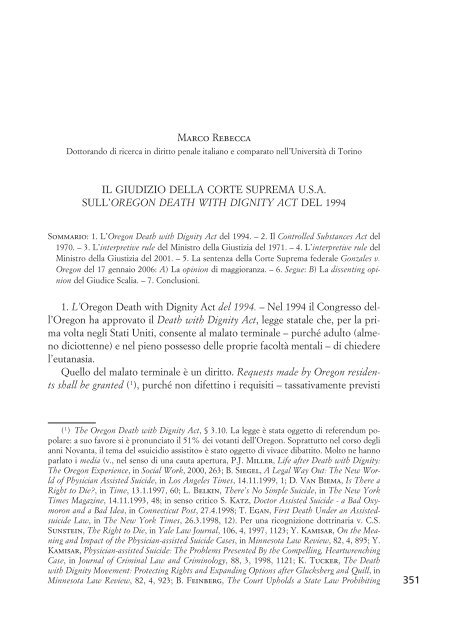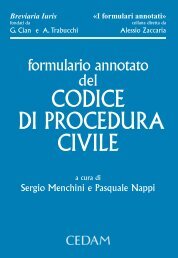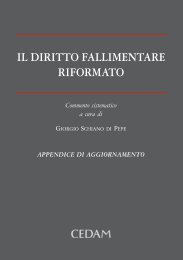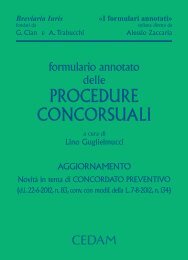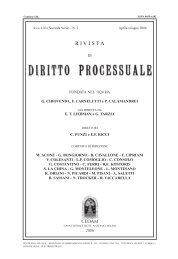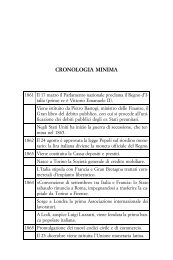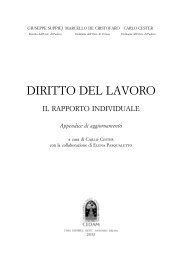Rivista Diritto penale 21 sec. n. 2-2006 - Cedam
Rivista Diritto penale 21 sec. n. 2-2006 - Cedam
Rivista Diritto penale 21 sec. n. 2-2006 - Cedam
Create successful ePaper yourself
Turn your PDF publications into a flip-book with our unique Google optimized e-Paper software.
Marco Rebecca<br />
Dottorando di ricerca in diritto <strong>penale</strong> italiano e comparato nell’Università di Torino<br />
IL GIUDIZIO DELLA CORTE SUPREMA U.S.A.<br />
SULL’OREGON DEATH WITH DIGNITY ACT DEL 1994<br />
Sommario: 1.L’Oregon Death with Dignity Act del 1994. – 2. Il Controlled Substances Act del<br />
1970. – 3. L’interpretive rule del Ministro della Giustizia del 1971. – 4. L’interpretive rule del<br />
Ministro della Giustizia del 2001. – 5. La sentenza della Corte Suprema federale Gonzales v.<br />
Oregon del 17 gennaio <strong>2006</strong>: A) Laopinion di maggioranza. – 6. Segue: B) Ladissenting opinion<br />
del Giudice Scalia. – 7. Conclusioni.<br />
1. L’Oregon Death with Dignity Act del 1994. – Nel 1994 il Congresso dell’Oregon<br />
ha approvato il Death with Dignity Act, legge statale che, per la prima<br />
volta negli Stati Uniti, consente al malato terminale – purché adulto (almeno<br />
diciottenne) e nel pieno possesso delle proprie facoltà mentali – di chiedere<br />
l’eutanasia.<br />
Quello del malato terminale è un diritto. Requests made by Oregon residents<br />
shall be granted ( 1 ), purché non difettino i requisiti – tassativamente previsti<br />
( 1 ) The Oregon Death with Dignity Act, § 3.10. La legge è stata oggetto di referendum popolare:<br />
a suo favore si è pronunciato il 51% dei votanti dell’Oregon. Soprattutto nel corso degli<br />
anni Novanta, il tema del «suicidio assistito» èstato oggetto di vivace dibattito. Molto ne hanno<br />
parlato i media (v., nel senso di una cauta apertura, P.J. Miller, Life after Death with Dignity:<br />
The Oregon Experience, inSocial Work, 2000, 263; B. Siegel, A Legal Way Out: The New World<br />
of Physician Assisted Suicide, inLos Angeles Times, 14.11.1999, 1; D. Van Biema, Is There a<br />
Right to Die?, inTime, 13.1.1997, 60; L. Belkin, There’s No Simple Suicide, inThe New York<br />
Times Magazine, 14.11.1993, 48; in senso critico S. Katz, Doctor Assisted Suicide - a Bad Oxymoron<br />
and a Bad Idea, inConnecticut Post, 27.4.1998; T. Egan, First Death Under an Assistedsuicide<br />
Law, inThe New York Times, 26.3.1998, 12). Per una ricognizione dottrinaria v. C.S.<br />
Sunstein, The Right to Die, inYale Law Journal, 106, 4, 1997, 1123; Y. Kamisar, On the Meaning<br />
and Impact of the Physician-assisted Suicide Cases, inMinnesota Law Review, 82, 4, 895; Y.<br />
Kamisar, Physician-assisted Suicide: The Problems Presented By the Compelling, Heartwrenching<br />
Case, inJournal of Criminal Law and Criminology, 88, 3, 1998, 11<strong>21</strong>; K. Tucker, The Death<br />
with Dignity Movement: Protecting Rights and Expanding Options after Glucksberg and Quill, in<br />
Minnesota Law Review, 82, 4, 923; B. Feinberg, The Court Upholds a State Law Prohibiting 351


